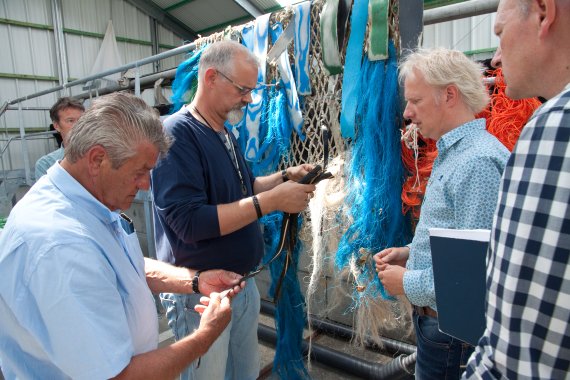Assessing alternatives for dolly rope. © Wouter Jan Strietman
When fishing for plaice and sole, fishing nets drag along the bottom of the sea, causing them to wear at a faster pace or get stuck and tear. That is why bunches of orange and blue thread hang off the nets. This dolly rope is attached to the parts that are most exposed to wear and tear and functions as a buffer between the bottom and the net. The Dutch fishing industry uses several dozen tonnes of dolly rope each year. About 25 percent of that wears down within two months, with all associated consequences.
‘Everything that is lost here in the North Sea follows the stream to the north and washes up on the beaches’, Strietman says. There is an average of a hundred pieces of dolly rope on each one hundred metres of beach. On the small German archipelago of Heligoland, the northern gannets use the dolly rope to build their nests. Birds sometimes also get entangled.
Testing
Within project VisPluisVrij (DollyRopeFree), fishermen actively seek an alternative material for dolly rope. ‘We are focusing on cheap materials that are strong, flexible, durable, recyclable and degradable in sea water’, Strietman explains. Many materials seem suitable at first, but turn out not to be good enough in practice. Natural fibres such as sisal and hemp were found not to be able to withstand the large forces exerted on the material. ‘Those fibres were worn after a fishing trip of just several hours.’
Natural fibres were worn after a fishing trip of just several hours.
Wouter Jan Strietman
In the past years, dozens of options have been tested at sea by fishermen. This summer, the most successful materials so far are tested as long as possible. The most promising alternatives are biodegradable plastic and yak leather.
Yak leather
According to Strietman, the switch to yak leather is not that farfetched. In the old days, dolly rope used to be made from cow leather. However, the ships and nets were smaller then, and cow leather was strong enough. ‘Yak leather is quite a bit thicker and works just as well as plastic dolly rope in the short term’, Strietman explains. The upcoming research should reveal whether the leather can be used in the long term as well.
Additional reading:
Little plastic in North Sea fish
Spitsbergen is the waste pit of the ocean

